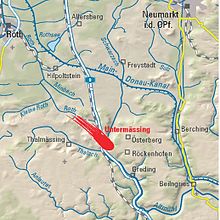Meteorite Fall Untermässing (1807)
| Meteorite Fall Untermässing (1807) | |
|---|---|
| place | Undermassing |
| Locality | Katzenberg, east of Untermässing |
| Fall time | possibly 9 August 1807, 8 p.m. found in May 1920 |
| Coordinates | 49 ° 5 '25 " N , 11 ° 20' 0" E |
| origin | Asteroid psyche |
| Meteorite name | Unter-Mässing |
| collection | Natural History Museum Nuremberg |
| authenticity | for sure |
The Untermässing meteorite fall marks an impact event in Germany in 1807 .
It was not until 113 years after his case was meteorite from Untermässing of two forest workers in May 1920 discovered under a tree root. According to researchers, the rare iron meteorite had a mass of around 2 tons before it entered the atmosphere.
History of the meteorite
Case report
Possibly the fall of the meteorite was recorded by the meteorite researcher Ernst Florens Friedrich Chladni : In 1819 Chladni wrote that “1807, August 9th, at 8 o'clock in the evening, a ball of fire moving east of Nuremberg towards the south was noticed”. The time and direction of the Untermässing meteorite would match Chladni's records.
Find
In May 1920, the two forest workers Johann Schäfer and his brother Georg, while clearing root stocks with a hoe, came across a metal block that was firmly enclosed by the roots of an old spruce . They uncovered what is today the largest iron meteorite in Germany that has survived . In the evening the two brothers covered the meteorite with earth so that it would not be stolen and the next day they took it to the village with the help of a wheelbarrow.
Rescue from the meltdown
Word quickly got around and a scrap dealer from Thalmässing offered the brothers 2 marks for the iron lump. Naturalist and local researcher Franz Kerl (1873–1956) identified it as an iron meteorite and saved it from destruction: before it was used in museums, iron meteorites were usually melted to extract the high-quality iron . The Schäfer brothers finally received 150 marks and 20 marks for the transport. Guy got 150 marks for arranging the unique piece.
Surviving the Second World War
Its place of storage, the Nuremberg Luitpoldhaus , in which the Museum of the Natural History Society was housed, was destroyed in the Second World War. Three years after the end of the war, the meteorite buried in the cellar was rediscovered and recovered by association members. Fortunately, the heat from the building fire had not damaged the structure of the metal.
description
The meteorite was surrounded by the roots of a spruce tree at a depth of 1.5 meters. That means that it must have been felled before the tree was there. After the spruce was dated to an age of around 120 years based on its annual rings , it can be assumed that the meteorite fell around 1800.
The meteorite consists of almost 90 percent iron. Two aspects are exceptional:
- It is the largest preserved meteorite in Germany. It must therefore have been a stately meteor when it entered the earth's atmosphere. The investigations of Hans Voshage at the Max Planck Institute in Mainz (incidentally one of the first German scientists who were allowed to examine moon samples from the Apollo 11 mission ) showed that it had an original mass of around two tons.
- It is rare: the criss-cross crystal structures on the etched polished surfaces (so-called Widmanstättensche figures ) are much finer than usual. Only about 1.4 percent of all iron meteorites belong to this group . In general, it is the only iron meteorite that has been found in Bavaria so far.
Whereabouts
The largest part of the meteorite, a good 78 kilograms, is exhibited in the Natural History Museum in Nuremberg. Today the collections of the Natural History Society in the Norishalle mainly concern the areas of geology , karst and cave studies , prehistory and archeology , as well as ethnology .
A piece weighing around 130 grams can be viewed in the Rieskrater Museum in Nördlingen . Two more pieces are in the Mineralogical State Collection in Munich. One of them (188 grams) was given to the famous mineralogist Hugo Strunz in 1951 for his help in salvaging the meteorite from the war rubble.
See also
literature
- Not from this world. Bavaria's meteorite. Bavarian State Office for the Environment , Augsburg 2012, ISBN 978-3-936385-92-2 .
- Entry in the Meteoritical Bulletin Database
Web links
Individual evidence
- ↑ EFF Chladni: About the fire meteors and the masses that fell with them . Heubner, Vienna 1819.
- ^ E. Preuss: The meteorite from Unter-Mässing . In: Annual Reports of the Natural History Society Nuremberg , Nuremberg 1976, pp. 49–54.
- ↑ Out of this world. Bavaria's meteorite. Bavarian State Office for the Environment, 2012, p. 40
- ↑ Out of this world. Bavaria's meteorite. Bavarian State Office for the Environment, 2012, p. 43
- ↑ Out of this world. Bavaria's meteorite. Bavarian State Office for the Environment, 2012, p. 94


